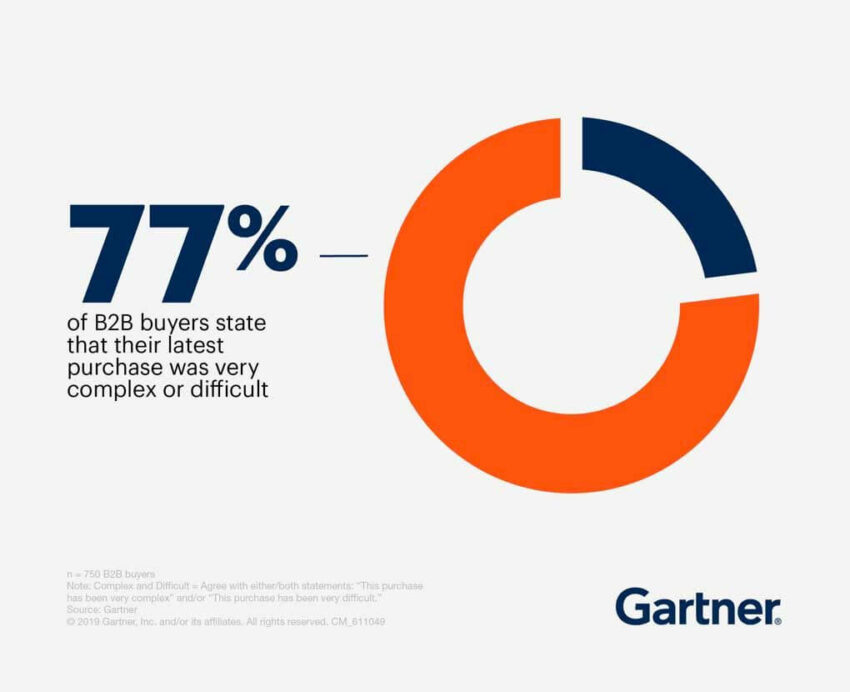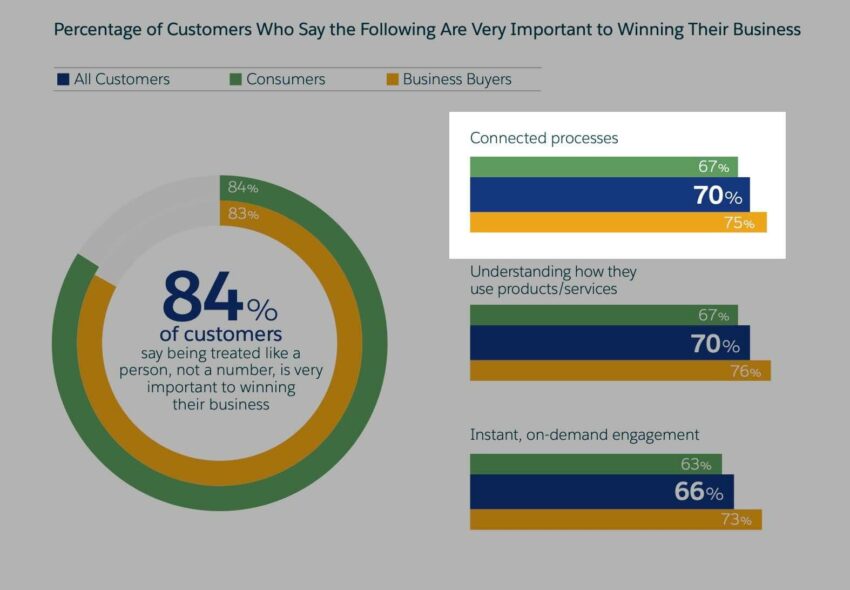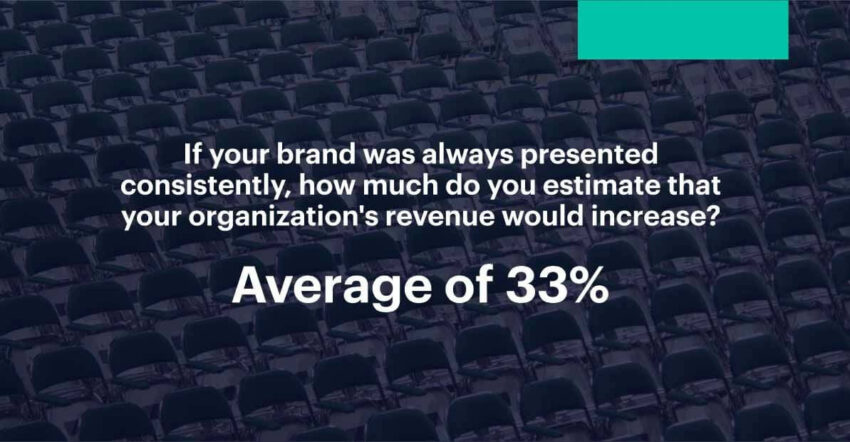How to Build a Sales Playbook Using a Customer-Centric Approach
Think about your personal buying experiences day-to-day. Everything we buy is on-demand, easy to access, and predominantly frictionless, or we look elsewhere.
Over the past decade, customer behavior has drastically changed. And the evolutions keep coming faster and faster.
However, if you look over here in B2B, the buying experience and the way we sell evolve at a much slower pace. But we’re entering an era where frictionless, on-demand expectations are bleeding into how we want to buy from other companies.
As you start to think about building a B2B sales playbook and what it should include, you need to engineer a process from the ideal customer experience – not the ideal selling experience.
This means:
- Mapping more than a single customer journey, but multiple so you can sell how people want to be sold to.
- Creating organization alignment around handoffs to make the process as frictionless as possible between Marketing to Sales development, Sales Development to Sales, Sales to Account Management, Account Management to Onboarding back to Account Management, etc.
- Consistent messaging across the brand, which varies way more than you would think across teams.
Too many sales playbooks over-engineer the process and forget about the experience. As customer/consumer patterns change more and more, B2B needs a customer-centric approach.
Why Should Your Sales Playbook Be Customer-Centric?
Customers are coming to the table more informed and have already singled out your company and other contenders for specific reasons. They expect to self-guide and not have to talk to multiple people to get what they want – even more information.
There is nothing more irritating for an informed buyer looking for a few final pieces of information to have to start from the very beginning of your sales process.
What does a customer-centric sales playbook look like?
A customer-centric sales playbook reverse engineers the ideal customer journey and then builds the sales process around it.
This approach takes a customer-first framework versus building your sales playbook around a sales methodology alone.
The reason? According to a recent Salesforce report, 82% of business buyers want the same experience as when they’re buying for themselves (see page 9 for the exact details).
Think about how I opened this article. Our personal buying experiences are on-demand, easily accessible, and frictionless.
Over the past decade and a half, Amazon has had a 41% YoY annual revenue growth using a formula that includes these three things. If that is what customers expect when they buy for themselves, that’s what we have to bring to the B2B customer experience.
B2B is always slow to catch the trends of buying and selling in B2C, but eventually, we get there. In the next few years, companies that don’t start to ingrain this into their culture and begin to build their sales playbooks around their buyers will lose against the companies that do.
How to Build a Sales Playbook that is Customer-Centric
I’m not going to cover the usual suspects regarding how to build a sales playbook. You can find that elsewhere.
Instead, I’ll cover three essential steps or elements that will help you develop a sales playbook that is customer-centric and built with the customer experience in mind.
Step 1: Map the end-user and the decision makers’ journey
There are two types of customer journeys that should be mapped before building your sales playbook: the experience of the end-user and the experience of the decision-maker and/or champion.
When you jam both customer journeys together, you have two stakeholders that care about entirely different things.
The end-users care about utility and making their day-to-day easier. Decision-makers care about the impact on the business. Therefore, the story you tell and the steps they need to take when evaluating your software or service will be very different.
The end user’s journey will be more about discovering and potentially testing your product during the sales process. The decision-maker has more of a financial journey ahead of them where they will be looking to interpret ROI.
Mapping both journeys will also help you accomplish two things:
- Understanding when to get the right people involved at the right time.
- And, by consequence, making the purchasing decision easier for your buyer.
Having 6 to 10 people to navigate in a typical, complex B2B purchase is challenging for sellers. It’s also challenging to navigate and get approval on the customer’s side, especially when they are distributed across departments such as the executive level, Operations, and Finance, who all have their own motives and needs.
Mapping at least these two types of journeys positions your salespeople as guides in the process, makes decisions and next steps clearer, and takes some responsibility off your customers’ full plates.

Step 2: Create organizational alignment around handoffs
To create proper organizational alignment around handoffs, you’ll need to ensure two things. The first, you’ve probably heard numerous times but maybe haven’t executed well. The second may be a bit controversial.
- Service level agreements (SLAs) that create a strong bridge between groups and remove friction in handoffs.
- Holistic compensation plans across the customer journey, not just a particular group’s specific piece of the process.
Both of these create alignment around handoffs and inherently create a better experience. Here’s why.
Service Level Agreements (SLAs)
When you sit down and start designing your SLAs, instead of identifying what internal groups need from each other, determine how you can make your process smoother for customers.
Creating a seamless experience that doesn’t break down between groups is more critical for business buyers than consumers. 75% of B2B buyers say connected processes, such as seamless handoffs or contextualized engagement based on previous interactions, are very important to winning their business. SLAs are how you create and monitor these handoffs.

Compensation Plans
In most organizations today, groups are only compensated for their part of the journey: leads, meetings booked, sales, renewals, etc.
What breaks down in the customer journey is groups are only interested in getting their part done and over the line to the next group. This doesn’t make for a great customer experience or, in many cases, the right customers.
Changing compensation to take a more holistic view was a game-changer when HubSpot decided that customer retention should be used as a basis for their sales incentive model. Customer churn dropped 70% within six months, proving that customer retention is greatly affected at the sales stage.
But the customer journey begins long before buyers get to Sales. Marketing and Sales Development should also be incentivized on the entire customer journey (or at least more of it).
If Sales is comped on deals and even further on renewals, Marketing and Sales Development should get comped on deals closed to connect them more to the process.
Incentive and compensation plans can increase employee productivity by 44%, but the trick is also not to make them too complicated.
I mentioned how creating a compensation structure like this can be controversial, and it could be dependent on the stage of your business.
If you’re trying to build a customer-centric playbook, worst case, you have to have a strong handoff between groups, and if you can, a compensation structure that incentivizes your people to focus on the full customer journey.
Step 3: Messaging must be consistent across the brand
If you analyze the best brands in the world, the brands that feel the most luxurious or innovative, the principle that they all have in common is consistency.
Consistent presentation of a brand has been seen to increase revenue by 33%. It’s easy to see in B2C or when walking into businesses with an enormous brand presence.
Take SoulCycle, for example.
No matter what SoulCycle you walk/ride into, you’ll have the same experience no matter what location you are at.
With so much of the B2B experience being digital, it can be hard to think of messaging within your brand as something as tangible as a SoulCycle experience, but it is.
What a customer reads, watches, and hears from your Sales Development them, Sales, then Account management are all interactions with your brand and your message. It can become very disconcerting when it’s inconsistent to where what you’re saying almost sounds false because a customer heard something different from someone else. Or you’re saying one thing while your website says another.
Like the other two steps laid out here, the entire customer journey must be ingrained within the Sales Org and the building of your sales playbook, so Sales understands the messaging, interactions, and brand language a customer had before coming to them and will have after.

To Get Started, Do A Customer Journey Audit
There you have it. How to build a sales playbook using a customer-centric approach:
- Map at least two customer journeys; the end-user and decision-maker
- Make sure you have solid bridges between your groups for smoother handoffs, and hopefully, align compensation to make the journey even more seamless.
- And finally, consistency. Consistency in messaging, the way you talk, the questions you ask.
If you’re unsure if your current playbook takes a customer-centric approach or a partial approach, you should first do a quick customer journey audit.
What is it like to buy from you? Is the process the best process for the customer? Or do you have a playbook based on what you and other team members want to happen?
A customer-centric approach isn’t a rip and replace of chapters in your current playbook. It will set your business up for the changing landscape of B2B Sales and what your customers will soon expect.
If your company is interested in learning more about adapting to this approach, reach out to me directly.